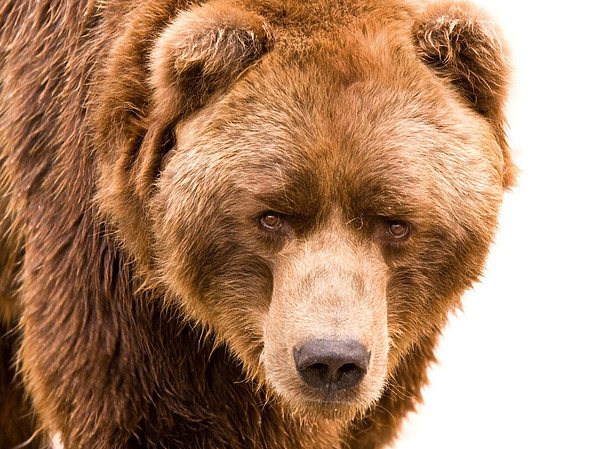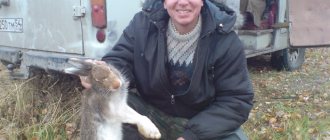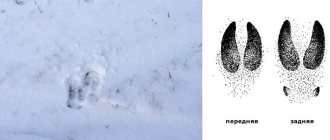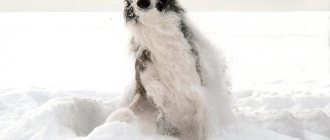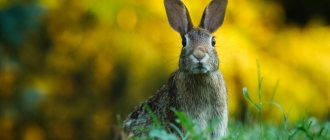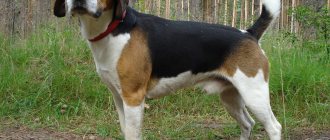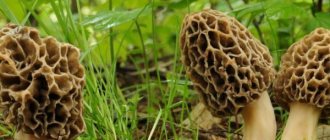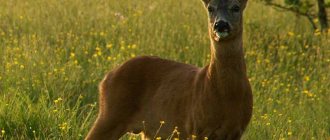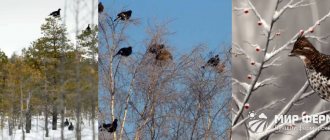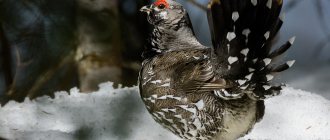Moose trail
It is difficult for an experienced hunter to confuse the tracks of an elk with the tracks of other animals. Of course, they are very similar to the hoof prints of cattle and some wild elk relatives, but they are significantly larger in size. The hooves of a male elk, even if of average build, are always larger than the hooves of the largest domestic bull. In general, the elk walks heavily and sinks deep into the loose snow, down to the ground. The stride length is usually about 80 cm. When trotting, the stride is wider - up to 150 cm, and when galloping, jumps can reach 3 meters. The width of the print, excluding the lateral toes, is about 10 cm for moose cows and 14 cm for bulls, and the length is 14 cm and 17 cm for females and males, respectively.
Photo of moose tracks in the snow added by user z.a.v.77. in 2017.
hare trail
Hares leave two long hind paw prints in front and two shorter front paw prints behind them. In the snow, the length of the footprint of the front paws is about 8 cm with a width of 5 cm, and the length of the hind paws is up to 17 cm, with a width of about 8 cm. Due to their specificity, the tracks of the oblique are not difficult to determine, as is the direction of its movement. Hiding from pursuit, a hare can make jumps of up to 2 meters, and in a “calm environment” the length of the jump is about 1.2 - 1.7 meters.
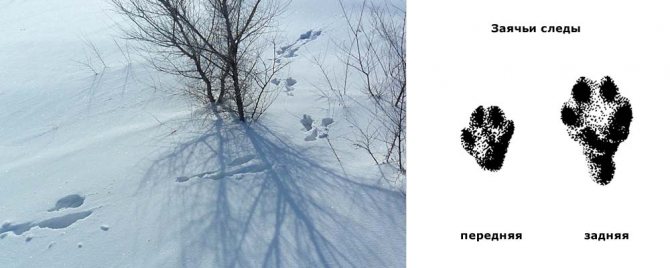
A photo of hare tracks in the snow was added by Laichatnik in 2015.
How to track a hare in winter
Usually the animal goes out to feed at night or early in the morning, so hunting should begin around this time period. During the daytime, the animal goes to the rookery and sleeps there after feeding. When reaching its lair, the scythe will create multiple obstacles for tracking. Thus, hare trails are likely to develop into loops and false paths, confusing the tracker.
Seeing hare tracks in winter will not be a problem, but their relevance may be questionable.
For example, after snow has just fallen, all old paw prints will be completely hidden. Only the freshest ones will remain (Figure 5), and until this time, hare tracks in the snow may be old and not relevant. To determine the actual prints, you need to find the fork marking the path to the lair. The length between repeating prints should correspond to several meters; all other chaotic paths will be false. It is worth remembering that the animal spends more time in the cold lying in its den than moving in search of food. It would also be a bad idea to hunt in windy weather, because all the prints will be covered up very quickly. Even if you are unlucky enough to scare away a hare at the rookery, return there after a while. Squints very rarely change their place of residence, and the chance of finding escaped game will be high.
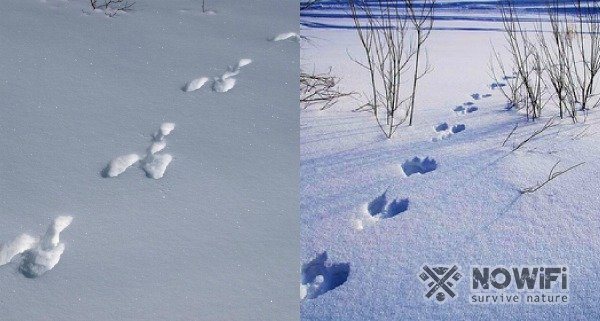
Figure 5. Fresh hare tracks on fallen snow
How to find a hare
The algorithm of actions if you notice the tracks of a hare in the snow will be as follows:
- It is necessary to determine the correct direction of movement of the animal. Following from the fats (Figure 6), focus on the hare's exits from the feeders. Walk parallel to the hare's path, bumping into a new feeding place, repeat the algorithm;
- As soon as you come across paired, double or looping prints, you are close to the animal’s bed. The bunny track trick in the snow is a tricky maneuver designed to confuse you;
- You should only fold it if you are sure that it is a print of the same oblique. For complete success, you need to circle every loop you encounter and look for intersections;
- Once the loop is completed, you will most likely encounter a "two" trail, which indicates the presence of game nearby. Namely, rookeries where you can set up an ambush. We remind you that the scythe very rarely changes rookery;
- Pay close attention to bushes, snowdrifts, boulders with crevices, ravines, depressions and ditches;
- The location of the oblique can be a hole dug in a snow pile. The hare's tracks are covered with fresh snow in winter. In windy weather, on the contrary, the animal lies in places inaccessible to the wind, pointing its nose towards the air flow;
- Brown hare is best caught while resting during the day and evening;
- Once you spot an animal, immediately head towards it with your gun at the ready. If the scythe is too far away, go around the lair, approaching the distance of a sure shot. Try not to look at the hare too often as this will scare the animal.
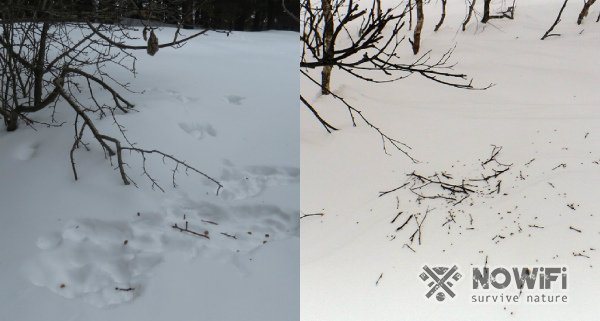
Figure 6. This is what a hare’s fattening area looks like in winter
Fox trail
Fox tracks allow an experienced hunter to determine the nature of its movement. A fox paw print is typically about 6.5 cm long and 5 cm wide. The step length is from 30 to 40 cm. However, during a hunt or when escaping pursuit, the fox makes fairly long (up to 3 m) jumps and throws forward, to the right or left - at right angles to the direction of movement.

Photo of fox tracks in the snow added by user kubazoud in 2016.
Animal tracks. How to determine the trail of an animal.
How to determine the trail of an animal. Learning to recognize animal tracks.
How to learn to identify and distinguish animal tracks? How to distinguish, for example, the track of a wolf from the track of an ordinary dog or the track of a white hare from a hare? How to learn to track an animal? Read about all this below! A visual aid for identifying animal tracks with descriptions and pictures.
A bear's footprint (especially the hind paws) is similar to a human footprint (with the exception of claw prints). The male's trail is slightly wider than the female bear's, and therefore an experienced hunter can easily distinguish the gender of the passing animal. The place where the bear passed can be seen even in the summer, because the animal strongly crushes and tilts the grass in the direction of movement. In addition, in the summer a bear will never pass indifferently past anthills, stones, snags, etc., but will definitely stir them up or turn them over.
Bear trail
The tracks of a wolf resemble those of a large dog, but since the wolf clenches his fingers more tightly, the lower part of his fingers is more convex, and the track is therefore more elongated and is more clearly imprinted on the dirt or snow. The main difference is that the wolf's track is correct and its direction is straight. The animal walks in such a way that the imprint of the right front foot fits into the back left one and vice versa, so the tracks stretch in a line, each such track is approximately 30-35 cm from the other (depending on the depth of the snow and the age of the animal). If a pack is walking, then those following the first animal step “footstep in footstep”, so the number of wolves in the pack can be found out when the pack enters the forest.
The freshness of the footprint (unless there was powder) can be recognized by the looseness of the snow, crushed by the feet of the walking animal; if the trail is old, then it and its edges freeze and become hard to the touch. A fresh footprint has a so-called “drag” - a thin line between the tracks, which disappears after a few hours (it appears because the wolf drags its hind legs a little on loose snow). The wolf does not often walk at a walk, but usually at a small trot. This tread of the beast seems wrong, but despite this, the wolf uses it to lay the most correct trail. If a wolf is jumping (“waving”), then the trail of the hind paw is approximately three fingers distant from the corresponding front paw.
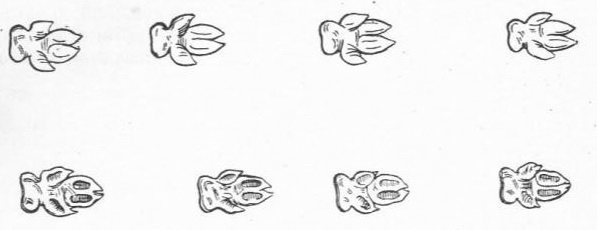
Wolf footprint on the ground (above) and on the snow (below)
A wolf's track can be easily distinguished from a dog's track if the track is fairly clear. A wolf's two middle fingers are located much further than the outer ones (if compared to a dog's track). The outer and middle fingers can be separated by an imaginary line, and this line will not intersect the prints of the outer fingers.
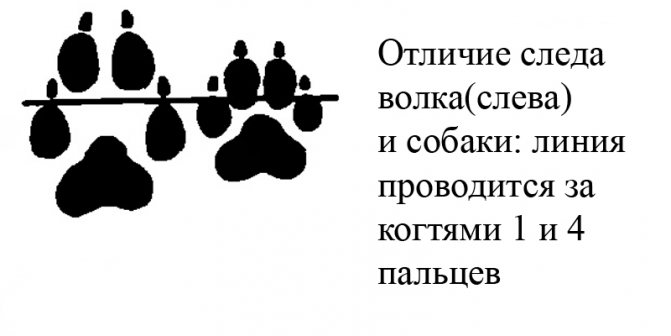
difference between wolf and dog tracks
comparison of wolf and dog tracks
The track of a fox resembles the track of a medium-sized dog, but the differences are also in the correctness of the gait and the tightness of the paw. Usually the fox steps in one line and, like the wolf, lays out the correct tape. The animal also walks to feed in two, very regular tracks, and can also move in four tracks, like a dog. The fox never makes a trail, and if it walks in a certain place for several days in a row, then each time it carefully follows the same trail. In addition, if she walks back in the same place, she rarely follows her oncoming trail, but tries to choose a different path.
The fox quite often makes loops, like the hare, but unlike the latter, it never takes notes. While lying down, she turns her head in the direction from which she came. It happens that an animal hides its tracks in a hare's trap. Experienced hunters are able to distinguish between the tracks of a male and a female - the male's is round and clean, while the female's is oblong, narrow and not so clean, since the female usually picks up the snow with her hind legs - scribbling.
fox trail
A lynx's track always has only one constant direction and is very similar to a cat's - it is round, with distinct fingerprints; in this case, the claws are imprinted only in the case of the fastest running.
lynx track
A moose footprint is larger than a deer one, and the cuts in the hoof diverge more widely. The moose always puts its legs straight and never “furrows.” Its droppings resemble those of a deer and consist of large hairs of a slightly oblong shape (but they are slightly rounder than those of a deer), which in males usually stick together, and in females fall apart. A bull's track is always rounder and larger than a moose's track.
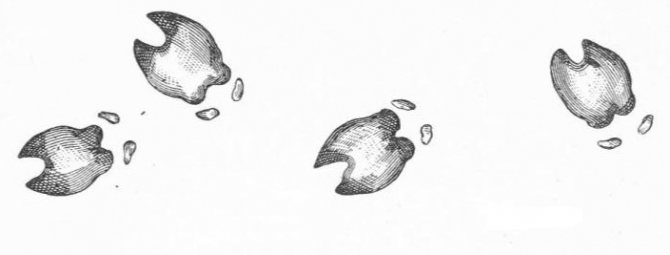
elk trail
The trail of a wild boar resembles that of a domestic pig, only sharper than the latter. In its outline, it resembles the trail of a red deer (especially if the trail was left by an old cleaver). The difference between a boar track is that the rear appendages diverge in the shape of grouse braids. They are wider than the footprint itself, are printed together with the hooves without gaps, and the distance between the traces is less. The footprint of a male differs from that of a female - the wild boar has larger toes, and the hooves are blunter and the same on any leg. In pigs, the hooves are very different in size from one another and, in addition, the footprint of a boar is wider than that of a pig, since it swings its legs more to the sides when walking. The age of the animal can also be determined by the size and depth of the footprint.
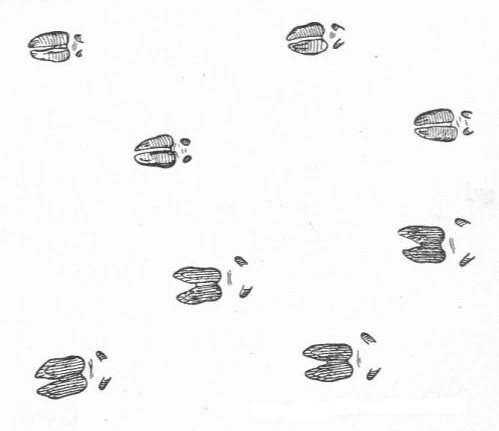
Boar tracks in the snow
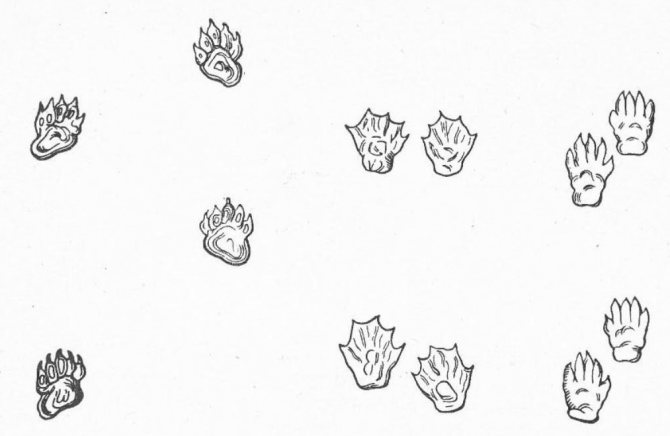
POROSHA
Powder is snow that fell at night and ended in the morning. Therefore, only fresh traces of animals that fattened at night are visible in the snow, which greatly simplifies tracking them. Real powder in central Russia usually occurs no earlier than the beginning of November. The powder is considered good if the snow is so deep that the footprint is clearly visible on it (and the footprint is continuous, that is, there are no large bare spaces.
The first powder is always formed by snowfall, the next ones can be a consequence of drifting snow. Therefore, powders can be upstream and downstream (drifted). But most often the powder is formed by the simultaneous fall of snow and drifting snow. Powders are divided by depth into fine, deep and dead. Small - if the prints of the hare's front paws are pressed no deeper than the lower joint; deep - if the snow falls to a depth of 10 to 15 centimeters, dead - when warm wet snow falls in an even layer 15-20 centimeters thick. Printed is called powder when each claw of an animal’s paw is clearly imprinted on the snow. Such powder occurs when shallow melting snow (warm powder) falls.
Warm powder does not deteriorate by the wind and therefore (unless it stops melting) can last the longest, since after warm powder you can look for fresh traces, very different from the blurred old ones, for two to three or even more days.
Depending on the duration of the night snowfall, the powder can be long or short. The long powder was snow, which quickly stopped, and therefore the animal managed to leave a lot behind. Conversely, a short powder is a short trail because the snow fell all night or even continues to fall. Deep (and especially dead powder) is certainly short, because the animal (especially the hare) always wanders a little. Regarding the noise that the hunter makes when approaching, the powder can be soft (in warm weather) and hard (in frosty weather, when the snow is loose). Hard powder is always inconvenient for approaching, because the noise made by the hunter scares the animal away.
Powder, good in the morning, can deteriorate or be destroyed by snowfall or drifting snow. In general, after a strong snow drift, tracking is rarely successful. In addition, you need to keep in mind that ground powder can only be in open places, so on the edge of the forest and in forest clearings in the wind, searching for fresh traces is very difficult. On the contrary, if the drifting snow continues to sweep, then the tracks in the field will be swept away, but under the forest they will be very clearly visible. In the steppes there is almost always wind, and therefore during the day the powder there usually always spoils (with the exception of warm weather).
Traveling powder is the kind of powder when dry snow, like fluff, falls on the frozen ground and does not give the dog any support for its paws while running. With such powder, a dog slides and runs across the frozen ground, as if on ice. Powder is very important for hunting animals, especially hare and also for gun hunters. They can track the beast on skis throughout the winter.
MALIK
Malik is the entire path of a hare, marked during the night in the snow, from its bed, where it spent the day, to the feeding area (the place where the hare fed), and back to the den. The ability to recognize a variety of hare tracks is very important, especially for those hunters who plan to hunt a hare by tracking.
It is quite difficult to track white hare, and therefore hare are more often “tracked”. It is difficult to see the white hare in winter when lying down; moreover, it very much confuses the passages and often lies down in a “strong” place. In addition, tracking hare is a very tedious task. He greatly confuses his moves, fills paths, runs into the tracks of other hare, circles and makes loops a lot. Therefore, in areas where both hare and hare are found, it is very important to be able to distinguish them by their tracks, which is achieved quite quickly.
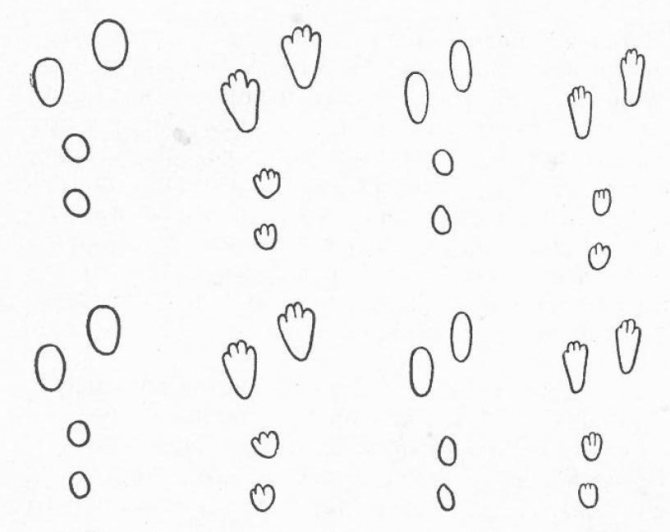
The white hare that lives in the forest, where the snow is slightly looser than in the field, has wider and more rounded paws, the toes spread wider, and the animal leaves footprints in the snow that resemble a circle; The hare's footprint is oval. When the snow is not so loose (with printing powder), individual fingerprints appear. But the hare's hind paw prints are still slightly wider than those of the hare. More elongated and parallel to each other and slightly ahead of each other, the hare's tracks belong to the hind legs, and those similar in outline to a circle and running one after the other, along a line, belong to the front legs.
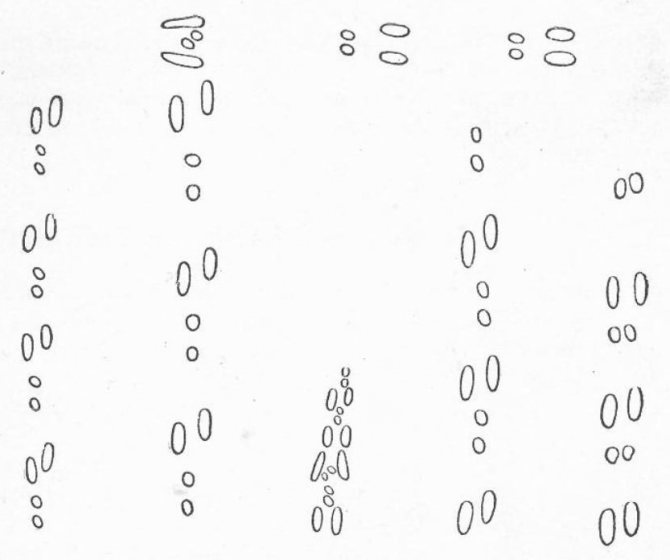
A sitting hare leaves a different mark. The prints of the front paws are located almost together, and the prints of the hind paws lose their mutual parallelism. Since the animal, when sitting, bends its hind legs to the first joint, then in the snow, in addition to its paws, the entire pasanka is also imprinted. (In the figure below, the prints of the hind paws with pazankas are shaded.) If we exclude this case (when the hare is sitting), then the prints of the hind paws always remain parallel to each other, and if tracks are noticed in which the prints of the hind paws go apart (i.e. clubfoot) ), then these are not hare tracks, but cats, dogs or foxes when they gallop. The same can be said about a footprint in which one hind paw is significantly ahead of the other.
footprint of a sitting hare
The normal track of a hare is large jumps. In this case, the animal puts out its hind legs almost simultaneously, and places its front legs one after the other. Only when the jumps are very large does the hare put his front paws almost together. The usual tracks of a hare are called end tracks, since with such measured jumps he goes to the fat and returns from it. The difference between fat marks and end marks is that the paw prints are not far apart from each other, and the individual marks practically merge. Such marks are called fat marks because animals leave them where they feed, moving slowly and often sitting down. The hare leaves marking marks (in other words, sweeping marks) in large jumps, which it makes at an angle to the original direction of movement.
With skimpy tracks, the hare tries to hide, interrupt his own trail, before he plans to lie down. Usually there are one or three “discounts”, occasionally four, after which the usual, terminal traces follow again. As a rule, before making a discount, the hare doubles its tracks. The hare's skid jumps differ from the end tracks in the distance between the tracks, and also in the fact that the prints of the front paws are located together. The hare makes rutting (restless) tracks when it is frightened from its den - and then the animal moves in big leaps. Racing tracks are very similar to jump tracks or end tracks (only in the opposite direction), since the prints of the front paws are closer to the prints of the hind paws of the previous, rather than the same jump.
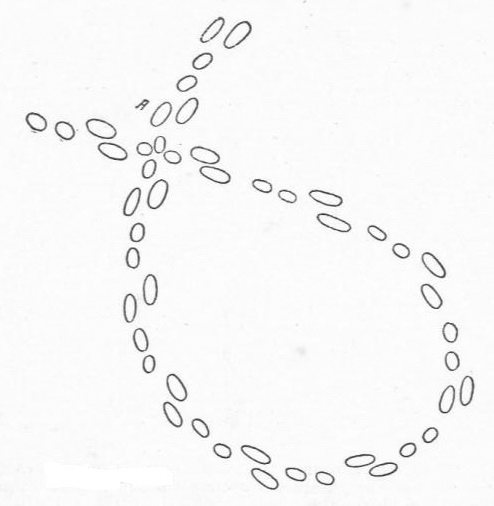
cleft loop
From the place where the hare sat before dusk, the malik usually begins with fatty traces, which then turn into terminal ones. They sometimes go straight to the fats, where the hare always moves in small “steps”, often stops and sits down. After feeding, the hare sometimes runs and plays, and immediately comes across rutting tracks. Having run up, the animal feeds again, or already at dawn it moves from the fat along the trailing tracks to a new lair. Before choosing a reliable place to lie, the hare begins to meander, again crossing its previous tracks. Sometimes such loops occupy large areas. At point A, it is rarely possible to say with certainty, without turning the loop, that the tracks belong to the descending malik or that another hare passed here.
It is rare to see more than two loops. After them, “twos” and “threes” begin (doubling or building a trail). In this case, the traces can overlap each other, and here skill and ability are required to distinguish a double trace from a regular one. After a “two,” the hare most often makes a discount to the side, but after a “three” (rare), there are usually no marks, and the animal gallops on for a considerable distance. Usually, the hare's "twos" and "threes" are seen along roads or ridges of ravines, where, as a rule, there is little snow, and at the beginning of winter - in meadows, in hollows and on recently frozen rivers and streams. The length of the “twos” is variable and can vary from five to one hundred and fifty steps. “Deuces” indicate the proximity of the bed, and if a hare after a “two” with a discount goes a considerable distance, changing the discount tracks to the end ones, then this is, as a rule, an exceptional case.
Threes, as a rule, are not very long and the direction of the trail after them usually does not change (and very rarely they are followed by a discount). Almost always the hare “throws off” at a right angle to the direction of movement; after several discount jumps there are several end jumps and again a second “two” with discounts. Quite often, Russians are limited to just two “twos,” but there are maliks where the number of “twos” reaches eight or more.
Bear tracks
The tracks of a brown bear are quite easy to recognize among the tracks of other animals. This heavyweight (on average his weight is about 350 kg) cannot pass through snow and mud unnoticed. The prints of the animal's front paws are about 25 cm long, up to 17 cm wide, and the hind paws are about 25-30 cm long and about 15 cm wide. The claws on the front paws are almost twice as long as those on the hind paws.
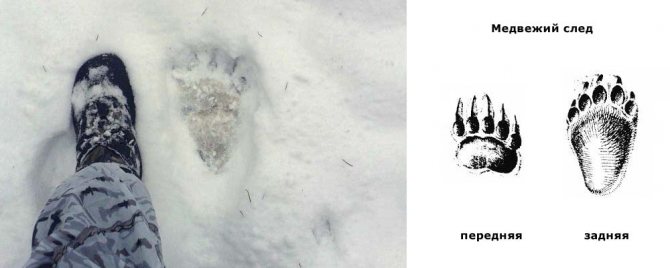
Photo of bear tracks in the snow added by user willi in 2016.
About the tracks of a brown bear
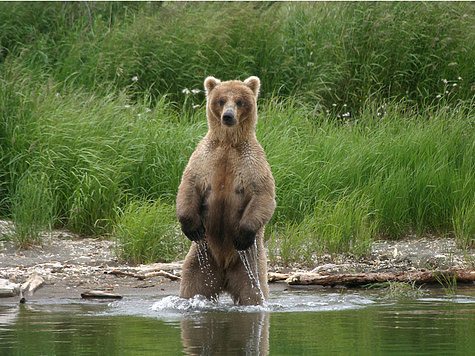
The height of the animal at the withers is 70–130 cm. The body length of some individuals (A. Cherkasov, 1867) reaches “20 quarters from nose to tail,” i.e. more than three meters. This is probably a rare case. Nowadays, animals up to 2 meters are considered large.
Brown bears are not picky about their habitat. They live on sea coasts, in the tundra, taiga, forest-steppe, and in the mountains. But in all cases there must be a good food supply. Berries, herbs, oats, corn, fish, ants, larvae, other animals - everything is eaten by the bear.
Bears that were unable to fatten up over the summer and autumn are forced to abandon their long winter hibernation. These are connecting rods. Their traces can be found in winter in the most unexpected places.
The bear leads a mostly solitary lifestyle in its favorite area. He regularly goes around it along his own paths and directions. He guards his area very jealously and drives out aliens.
The size of such areas in the northern regions of Russia is 20–25 sq. km. Groups of 3–4 animals form during estrus and in feeding areas.
While feeding on the grass, the bear walks slowly, waddles, with its head down. Sensing danger or chasing prey, it rushes at speeds of up to 40 km per hour.
Read the material “Not an easy bear: luck smiled”
In bear lands, the hunter will find well-worn paths, often laid in dense bushes or steep mountain slopes. When moving through the grass, the animal crushes and crushes the stems and leaves of plants, which, as they dry out, change their color, making the path especially noticeable.
When meeting each other, male bears begin to scare each other - they rear up and sway from side to side. The cowardly or weak runs away. If the forces are equal, a fight to the death can occur.
Bears have a highly developed sense of smell. It senses a person in a headwind at a distance of 300–400 m. Vision and hearing are slightly less developed.
At the end of October - beginning of November, bears go to dens and come out at the end of March - beginning of April. Their dens are very diverse in their structure. It could be simply a nest with a bedding of moss and spruce legs in a thicket of young spruce trees, a tray under a dry aspen, a depression under an inversion, a hole with a side spur, etc.
In all cases, traces remain in the area of the den by which its detection is possible. Broken spruce paws, torn out moss or blueberry twigs are all signs of the bear’s “work” in constructing a den.
Materials are used to line the bottom of the den. In addition, a den can be found by its “brow” - a hole in the snow through which the bear breathes. The snow along the edges of the brow is always yellowish in color.
Read the material “Behavior of a bear when meeting a person”
In central Russia, bears always go to the north to lie down in their den, and lie down with their heads to the south, i.e. to your heel. Therefore, the “face” of the den can most often be found on the south side.
|
| photo: Fotolia.com |
The tracks of a bear in fresh snow look like the tracks of a man in felt boots. The length of the step and the size of the prints are like those of a person. But a person places his feet with his heels inward and toes outward, and a bear does the opposite. As they say - clubfoot. When walking slowly, he places his hind paws on the tracks of his front paws and almost completely covers them.
After leaving the den, the bear finds it difficult to feed. To search for food, he rakes anthills, looks for larvae, breaking rotten stumps, eats buds from thin aspen trees, collecting the tops in an armful.
Traces of such feeding remain for a long time - groups of aspen trees tilt to the sides and lie on the ground. He also breaks off rowan trees to get berries in the fall, in the taiga he breaks off the tops of cedar trees with nuts, and destroys fruit trees.
In summer, bears leave their marks on the bark of trees. Rising to his full height, he scratches the tree with his hind legs and tears at the bark with the claws of his front paws. Probably, in this way he marks the boundaries of his territory and tells the uninvited stranger - look how huge I am!
Read the material “Brown bear and reaction to biotechnology”
The bear has five toes on all paws. When a bear walks slowly, the entire foot along with the heel leaves an imprint; if it runs quickly or runs, the heel does not leave an imprint. But in all cases, the entire foot is imprinted on the snow.
The length of the bear's front paw print is 20–25 cm, its width is 15–17 cm, and the hind paw prints are slightly shorter in length.
These are the main signs of the presence of this beast in a particular area.
All bear hunts are interesting and require maximum effort of moral and physical strength from the hunter.
Anatoly Kleptsov August 28, 2020 at 01:28 pm
More photos of bear tracks:
Wolf tracks
The tracks of wolves are very similar to the paw prints of large dogs. However, there are also differences. The front toes of a wolf are more forward and are separated from the hind toes by the width of a match, while in dogs, the toes are gathered together and such a gap is no longer observed. Experienced hunters can distinguish from the scent what kind of gait the animal moved at a walk, trot, gallop or gallop.
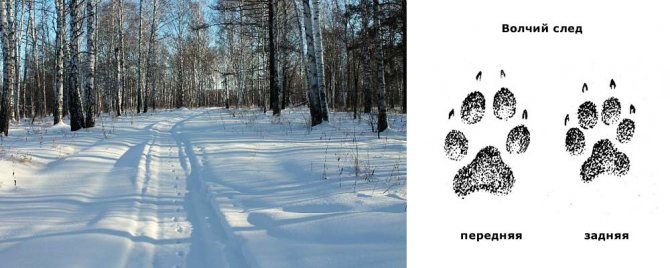
Photo of wolf tracks in the snow added by user Sibiriak in 2014.
Features of movement
The footprint of a lynx can theoretically be confused with the paw prints of a snow leopard, wolf, or jungle cat. One of the signs that characterizes that the prints belong specifically to a wild cat is the nature of its trail. A predator, moving on a hard surface or fine snow, leaves prints of its hind paws slightly ahead of its front ones (“double” them). In this case, the chain of traces is close to a broken line.
If the snow cover is deep, the animal places its hind feet clearly in the footprint holes of its front ones.

Despite the animal’s ability to stay on the snow, it nevertheless sinks slightly into loose snowdrifts, which complicates its movement and makes it impossible to determine the identity of the prints. If the foot print is unclear and blurry, the length of the animal’s tread will help determine that it was left by a lynx - it is shorter than a wolf’s and varies depending on the sex and age of the animal:
- The length of the female's step when the limbs are deepened into the snow cover up to 16 cm is 43-47 cm;
- The step of an adult male is larger and reaches 60 cm. When accelerating, the animal is able to take steps 80 cm long, but at the same time falls into the snowdrifts by 25-30 cm;
- Due to their low weight, young kittens dive into the snow no deeper than 10-14 cm, and the length of their steps is 30-40 cm.
Grown-up lynx cubs try to follow their mother, following her tracks, but they do not always succeed, since their stride length is shorter. During the transitions, the lynx calves frolic and play, leaving numerous imprints and crushed areas of the snow cover after somersaults.
The lynx, if possible, prefers to camouflage its tracks by making a path through secluded places, jumping onto trees and stumps, walking through thawed areas, rocky massifs or on ice.
Moving through deep snowdrifts, the predator gets tired, therefore, in order to save strength and energy, it prefers to use any paths left by other animals, forest paths and ruts made by skis.
More photos of wolf tracks:
Wolverine tracks
It is difficult to confuse wolverine tracks with anyone else's. The front and hind feet have five toes. The length of the front paw print is about 10 cm, the width is 7-9 cm. The hind paw is slightly smaller. The snow is often imprinted with a horseshoe-shaped metacarpal callus and a carpal callus located directly behind it. The first shortest toe of the front and hind paws may not be imprinted on the snow.
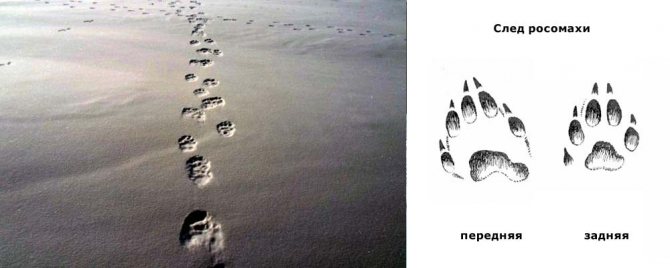
Photo of wolverine tracks in the snow added by user Tundravik in 2014.
Ways to track a hare
This animal has characteristic tracks. They may look different depending on what exactly he is doing. For example, if he goes to feed, then the markings, as a rule, will be terminal. Usually quite large jumps are made, in which the front paws are thrown out one after the other. Experienced hunters recognize the following hare markings:
- Discount prints - appear if the animal was frightened and is trying to escape pursuit. In this case, the jumps are usually very large and located at an angle. Such a print has a double footprint left by the animal’s paws. Sometimes such prints are called “estimates”.
- If an animal is looking for a place to hide, it leaves loops in the snow. They look like this: a semicircle with the intersection of the previous moves left by the scythe. The loop is sometimes quite large, which is extremely inconvenient for a person. Often the semicircle begins to bifurcate and already forms two or three loops. The length of each semicircle includes up to 150 hare steps. If it bifurcates, then finding the hare becomes extremely difficult.
- Sometimes, when running, an animal leaves quite large prints connected to each other. What marks do hunters call “rutting marks?” It is characterized by the connection of traces from two jumps.
- Hunters also distinguish fat marks that are difficult to confuse with others. Usually they are left by hares who came to feed. While eating, they sit down on the snow and therefore all traces, as a rule, are merged.
- Separately, the prints of a sitting hare should be noted. In such cases, a trace remains in the snow from the bend of all the limbs of the animal, including part of the body. Moreover, the hind paws usually leave a longer trail than the front paws.
Thus, while eating, the hare leaves fatty traces, after which he confuses them, moving to the place of hibernation. This is necessary primarily in order to deceive predators. Sometimes it returns to feeding with the scythe in the morning so that it can get a good night's sleep during the day.
Boar tracks
It is not difficult to distinguish the footprint of an adult wild boar from the traces of other ungulates, because in addition to the imprint of the hoof itself, a trace of stepson fingers located on the side remains on the snow or ground. It is interesting that in young piglets in the first months of life these fingers are not supporting, and therefore do not leave a mark.
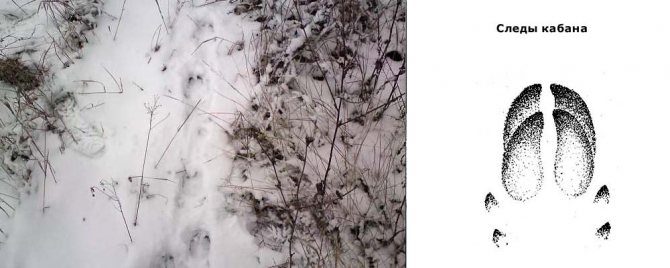
Photo of wild boar tracks in the snow added by user Hanter57 in 2014.
What paw prints does a dog leave?

Fox tracks in the snow are very similar to the paw prints of a small dog. The hunter must learn to recognize the “handwriting” of foxes and mongrels. The paw prints left by a fox in the snow are much slimmer and neater than dog tracks. If you look at the marks from the pads of the two front and back fingers, it becomes clear that a visual line can be drawn between them. In many dogs, the side toes wrap around the sides of the hind toes, extending forward. In photo 2 you can see the tracks of a dog and a wolf.
This is interesting: Cooking while camping
Sometimes the tracks of some dogs are difficult to distinguish from fox tracks. But there will be no doubt left if you carefully examine the straight chain of holes and the surprisingly even distances between them, as well as the regular curves on the front of the tracks. No dog can make such a drawing with very delicate lines. The fox has sharp claws, and the dog has worn ones.
More photos:
More photos of roe deer tracks:
Lynx trail
The size of the footprint of the front paws of adult individuals is about 8 cm in length and the same in width, the hind paws are slightly smaller. The length of a measured trot stride is about 60 cm for males and 45 cm for females. The young animals have a shorter stride, but they follow their mother in single file, trying to follow the trail.
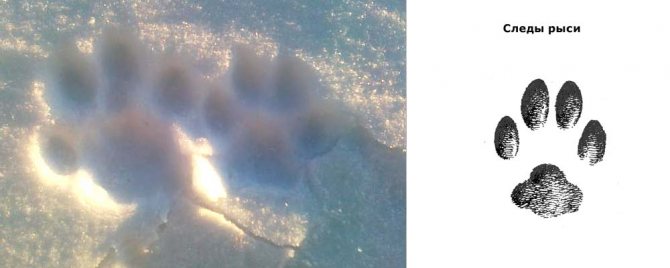
Photo of lynx tracks in the snow added by user Sasha_27 in 2012.
Squirrel tracks
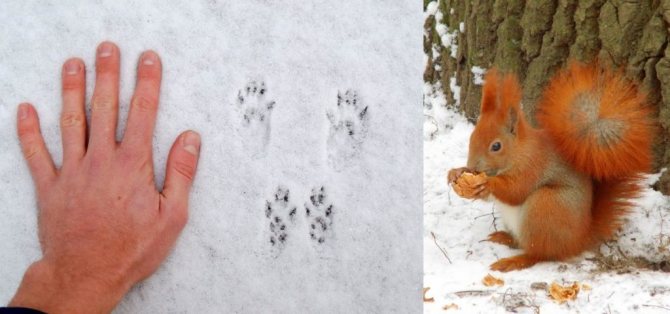
You can see what an animal has left behind both when the squirrel is walking “on top” and when it is walking “from below.” In the first case, she jumps from tree to tree, throwing sawdust, the remains of dry debris from a nest or hollow, and food debris onto the ground. When an animal walks “down”, its paw prints are visible on the ground or snow.
In summer, squirrel tracks can be seen on the road dirt or near a forest puddle; at this time they are not too pubescent, as in winter, and are more like rat tracks. The arrangement of the tracks resembles a trapezoid with four points, which are the prints of each of the paws with claws no more than 5 mm long. The prints of the front paws are located almost together, they are smaller than the hind paws, which are more spread out and located on top of the front ones. On the prints of the front limbs you can notice indentations due to calluses located in the lower part of the paws. The first toe (inner) of the hind legs is shorter than the others. The squirrel's tracks can also be compared to those of a hare, since it also moves spasmodically. When jumping, she brings her hind legs far forward, so they are imprinted on the ground in front of her forelimbs. The length of a squirrel's jumps depends on the speed of its movement. When moving calmly, the length of the jumps is usually 66-86 cm. At the same time, the width of the track on the snow is 11 cm. Unlike hare prints, which are located sequentially, squirrel prints are at the same level. On the hind paw prints, five toes of the same size are visible; on the front paw prints, the first toe is invisible because it is short. It is characteristic that, no matter what gait the squirrel moves, the position of its tracks does not change, except for those moments when it makes short jumps practically in one place.
In summer and autumn, squirrels can also be recognized by other types of tracks - food remains scattered under spruce and pine trees. On the caps of the mushrooms you can recognize grooves from squirrel teeth, which are wider than those of other small rodents that live in the forest. On the branches you can often find supplies hung by squirrels in the form of dried mushrooms, from edible to fly agarics, as well as the bones of other animals that gnaw on squirrels, replenishing their body with minerals contained inside bones or elk antlers.
More photos:
Sable trail
Sable tracks in the snow are usually not clear; not every hunter can notice and recognize them. In terms of the size of the print, they are not inferior to fox tracks, and when moving with a three-legged foot ( 3 ), their character resembles that of a hare. Basically, the animal moves with a step characteristic of all mustelids - a two-step step ( 1 ). On dense snow, the imprint can be from 7 to 10 cm in length and up to 6 cm in width. In this case, the length of the jump is on average 45-75 cm. On loose snow, paired prints most often merge into one hole ( 2 ) and the length of the jump is no more than 30 cm. However, when escaping from a chase or while hunting, a sable can jump up to 2 m.

Photo of sable tracks in the snow added by user Valdemar38 in 2017.
Determining the freshness of a trace
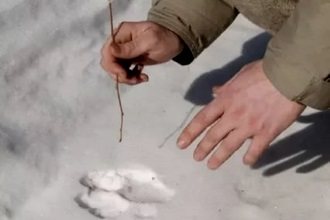
The lynx has excellent hearing, sees perfectly in the dark, and therefore leads an active lifestyle mainly at night and twilight. In search of food, an animal can travel from 5 to 15 km, so tracks that are more than a day old are very likely to be useless for detecting the animal.
A novice hunter or naturalist, in order to understand the difficult science of orienting by tracks, initially needs to compare his fresh print and the predator, take a photo for a detailed comparison. If there are practically no differences in these prints, then the animal may be nearby. To understand what yesterday’s footprint looks like, in the evening, before going into the forest, you should leave an imprint of your hand on the ground or snow, and study it thoroughly in the morning.
Determining the freshness of foot prints depends on many weather factors - rain, snow, frost, wind.
In winter, if the lynx's track is not dusted with grit that fell a few hours ago, it can be considered recently left.
In frosty weather, on a dry, fluffy surface, the animal's fresh paw prints are loose, looking like shapeless pits. Around the trace depressions one can see a small amount of openwork snow that crumbled when the limbs were removed.
After a certain time, frost binds the edges of the mark with infusion; it smoothes out and becomes harder the more time passes. At an air temperature of -8...-12°C, prints harden within 20-30 minutes, at lower temperatures – after 10-15 minutes. Moreover, old foot prints covered with a strong crust can be lifted, they will have greater thickness.
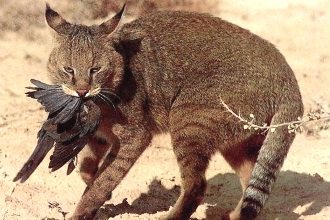
The novelty of a lynx's footprint can be checked by running a thin branch along the footprint. The branch will cut a fresh print (up to 1 hour) with ease; an old one (5-7 hours) will cut it, bending slightly. An imprint that is more than a day old will remain unchanged, but the branch will bend greatly.
The rate of deterioration of a trace is influenced not only by weather conditions, but also by the terrain - in open areas, prints fade and get swept away faster than in lowlands and ravines.
More photos of sable tracks:
In the comments, you can share links to your photographs of winter tracks posted on the website in the gallery of hunting photos in the “Pathfinder” section.
